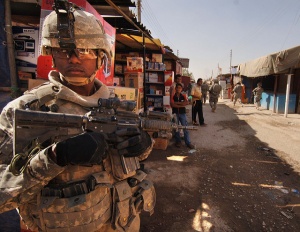When Lies Ignite Disastrous Wars
By Soura Alzubeidi, contributing writer
In the past 50 years, America has been at war nonstop. And so far, we have learned so little, and achieved even less.
America has adapted a military-first approach to the world with continual focus on building more and stronger forces. Developing and deploying revolutionary destructive technology has left us in a repetitious cycle of invasions, occupations, insurgency, and proxy wars. America’s failed foreign policies are evident in its history of disastrous wars.
It has become exhausting with different administrations and Pentagon being involved in almost every single major war and starting counterinsurgency campaigns to drone wars and special operation raids. Military or “militarized” solutions are not the right response to global problems. We have been deeply embedded into a propaganda machine of militarism.
When the U.S. goes to war, there has always been a triggering event. This triggering event then becomes a crisis that electrifies popular opinion and becomes the leading force for military intervention. However when exposed, it is then we find out about the misguided perception or the fabrication of said triggering event. The U.S. is in a cycle of lies, deception, and disastrous military intervention insofar their political policies go.
For example, President Lyndon B. Johnson used the so called attack in the Gulf of Tonkin to justify a massive military intervention in Southeast Asia. The man that pushed for the war was Secretary of Defense Robert S. McNamara. After the first real attack on the USS Maddox in the Gulf of Tonkin, McNamara reported there was another second attack. However, there was no evidence of an attack and that false radar images were used as proof.
McNamara even asked the Pacific Commander Mr. Sharp, “Was there a possibility that there had been no attack?” Sharp admitted that there was a “slight possibility” because of freak radar echoes, inexperienced sonar men, and no visual sightings of torpedo wakes. The admiral added that he was trying to get information and recommended holding any order for a retaliatory strike against North Vietnam until “we have a definite indication of what happened.” McNamara withheld the information from the president and continued the claim of the mysterious attack.
President Jonson was then labeled weak for being hesitant of a military intervention. He then surrendered to the pressure after a joint letter was sent to him by his advisors making it clear that the responsibility for U.S. “humiliation” in South Vietnam would fall on his shoulder if he continued with his policy of “passivity.” Fearing the blame will fall on him for the loss of South Vietnam, he began a bombing campaign in North Vietnam. The human cost of the war in Vietnam was 3 million Vietnamese and 58,000 U.S soldiers.
Another lie that paved the way into an unnecessary war with a so called “ally” was the notorious Nayirah testimony. Before the Iraq-Kuwait war, Saddam Hussein was a favorite ally of the U.S. for his strong opposition against Iran.
In a tearful testimony in front of the Congressional Human Rights Caucus, a young girl, famously known as Nayirah al-Sabah, claimed that she witnessed Iraqi soldiers taking babies out of incubators in a hospital, stealing the incubators, and leaving the babies to die on hospital floors.
It was later revealed that al-Sabah was the daughter of Saud Al-Sabah, the Kuwaiti ambassador to the United States. In fact, Citizens for a Free Kuwait, organized by the Kuwaiti government, hired consulting company Hill and Knowlton to gain support for U.S strikes. Even though the firm was to provide only “stylistic” assistance, they actually provided witnesses, wrote the testimony, and coached the witnesses. The Hill and Knowlton firm was paid $14 million by the U.S government for promoting the Gulf War.
The Iraq war of 2003 was a disaster of deception. Persuaded by Vice President Dick Cheney, President George W. Bush believed that Iraqi President Saddam Hussein possessed weapons of mass destruction, including a nuclear facility. In addition, he believed there were clear connections between Iraq and the Al- Qaeda terrorists who were responsible for the 9/11 attacks. A distraught nation looked up to the administration for security. So the CIA bent evidence to fit the fabricated facts and urged Congress and the American nation to endorse the deception. The administration became aggressive in their accusations of Iraq’s “weapons of mass destruction” and called for a regime change. By mid-April, the Iraqi army was dismantled and the government collapsed leaving the country in complete turmoil. On May 1, President Bush declared victory with his famous speech “Mission Accomplished.” However, no weapons of mass destruction were found. Iraq struggled for several years with bloody insurgencies and sectarian violence that the civilian population and especially the U.S government failed to foresee– and, until this day, the effects of the US-led invasion are present.
Unfortunately. when the facts become clear and the justifications for our military intervention are reexamined, a new rational is invented. It turns out, that the U.S. wanted to bring down a horrible dictator and create a democratic government in the Middle East.
The most recent U.S. involvement in the imaginary-democracy-process was the Arab Spring. While the U.S. carefully tip-toed around the revolutions that swept the region, Libya was not so lucky.
When the Arab Spring began in the Middle East, chaos and turmoil spread across the region. U.S. and NATO began to arm and supply the protestors, later known to be as rebels, in the name of humanitarianism. However, what began as “innocent” turned bloody. Anybody became a rebel and many were able to put their hands on guns looted from army and police stations. The media across the Gulf countries and NATO nations began to spread news of “genocide” and reported over exaggerated numbers of civilians killed by government forces during clashes. NATO and the United States entered the war on the false pretext of protecting civilians from Gaddafi’s mass slaughter–to this day, the figures are unclear and Libya remains a mess after the NATO airstrikes. NATO and the United States valued the overthrow of Gaddafi over any talks of negotiations or peace agreements. Admiral Samuel Locklear of the U.S Navy even admitted to Congressman Mike Turner that NATO wanted to assassinate Gaddafi.
Towards the end of the war, the rebels were proven to be unrepresentative, undemocratic, unstable, and failed to protect the civil and economic rights of the Libyan people. Tragically, the country still suffers from violence between different rebel groups and different tribes in the Southern Libya.
Fast-forward to 2016, we as citizens of the United States, the most powerful country in the entire world by ways of economy and military force must ask ourselves: what other lies must be told to engage in more disastrous wars?
18-21




















2016
1,564 views
views
0
comments